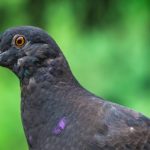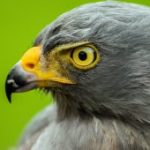A pigeon is any of several hundred species of birds forming the family Columbidae (order Columbiformes) (order Columbiformes). Smaller varieties are commonly termed doves, bigger versions of pigeons. An exception is the white domestic pigeon, the emblem known as the “dove of peace.”
Pigeons abound globally save in the coldest climates and the most inaccessible islands. About 250 species are recognized; two-thirds of them exist in tropical Southeast Asia, Australia, and the islands of the western Pacific, but the family also contains several representatives in Africa and South America and a few in temperate Eurasia and North America.
All members of the family suck liquids, rather than sip and swallow as do other birds, and all pigeon parents give their young “pigeon’s milk,” the sloughed-off lining of the crop, the production of which is promoted by the hormone prolactin. The nestling acquires this “milk” by putting its bill into the parent’s throat.

Can pigeons swim?
No, Pigeons are unable to swim in the water, primarily because they have a small and chunky body in addition to a short neck. The fact that pigeons do not have webbed feet is another reason why they can’t swim.

Why can’t pigeons swim?
Pigeons are unable to swim due to the structure and dynamics of their bodies, which prevent them from being able to do so.
They do not have any fatty acid or insoluble compound layers in their bodies, which would protect them from the effects of drowning if they did.
Pigeons, in contrast to most other birds, do not have webbed feet, which are normally used to help birds maintain their balance while swimming. In addition to not having webbed feet, their natural enemies make them very anxious.
However, in addition to pigeons, other birds, such as loons and ducks, are able to swim because the layers of fatty acids or other organic compounds that are on their feathers are insoluble in water. Pigeons are an exception to this rule.
Because of this, when they swim, their feathers stay dry, which enables them to swim without their feathers becoming heavy and causing them to drown as a result of the weight of their feathers.
Do pigeons have webbed feet so they can swim?
Pigeons can suffer from the webfoot mutation or a variant of polydactyly, both of which cause the pigeon to be born with webbed feet. However, this condition occurs in only a small percentage of pigeons.
It is not believed that this is an evolutionary trait that helps pigeons to swim; rather, it is a genetic abnormality in pigeons and in some cases, it can have an effect on their ability to walk. Pigeons are known to have this genetic abnormality.
In 1868, Charles Darwin made the observation that he would find multiple pigeons with webbed feet despite the fact that the majority of individuals of the same type of pigeon would have regular feet. This is the earliest documented case of pigeons having webbed feet.
he most widely accepted explanation for why some otherwise healthy pigeons have been observed over the years to have webbed feet is that the condition is the result of a simple genetic error. However, there are other potential explanations.
As was mentioned previously, having webbed feet can actually cause some pigeons to have trouble walking normally, which increases the likelihood that their enemies will be able to catch them while they are on the ground.
There is also no evidence of a preen gland developing in pigeons, which is a gland that waterfowl, like ducks, use to coat their bodies in waterproof oils to help them survive on water.
Pigeons, on the other hand, do not have this gland. This supports the idea that pigeons’ webbed feet are just a genetic mistake and not an evolutionary step toward being able to swim and live in water.
Can pigeons float?
The physical make-up of pigeons is a significant contributor to their ability to float. They are able to float in the water because, when they are on the waterbed, they extend their tail and open their wings. This increases the surface area of their structure, which allows them to do so.
These stocky birds make use of their intelligence by only wetting the upper portion of their feathers, which allows them to enjoy the process of floating without having to worry about drowning in the water.
Therefore, it is safe to say that these birds are capable of floating on water and actually do so. However, in order to avoid drowning, they can only float for a short period of time.
Do pigeons bath in water?
Pigeons are not bathed like dogs or cats because doing so will cause their natural oils to be stripped and will damage their feathers, both of which are conditions that are undesirable for the “show ring look.” Pigeons, on the other hand, need to have consistent access to bathing resources because, in order to keep their feathers in good condition, they engage in a behavior that is similar to bathing.
Pigeons, on the whole, do not appear to mind getting wet, unless, of course, they are attempting to rid themselves of parasites, in which case they appear to take pleasure in being wet.
Most of the time, pigeons will continue to stand or sit in the rain without trying to find shelter. It’s almost as if they don’t realize they’re getting wet.
There is also some evidence to suggest that getting wet can work to the pigeon’s advantage as it can force parasites off the pigeon’s body and improve general health while simultaneously reducing the potential risks of some other health issues developing because of parasite infestations.
On the other hand, exposure to cold water will have the effect of rapidly lowering the pigeon’s body temperature. However, this should not be too much of a problem for the pigeon in most circumstances.
Pigeons, like humans, appear to enjoy getting their feathers wet on hot days because it allows them to cool off more rapidly and with less effort than any other method.
The majority of tourist attractions that are well known for their pigeon populations typically have a water feature either on the grounds of the attraction or in close proximity to it. This gives the pigeons a place to fly to and allows them to cool off on hot days.
What birds can swim in water?
Ducks, geese, and swans are all examples of members of the Anserdia family. Some ducks are dabbling ducks, which means that they swim above the surface of the water. Other ducks, on the other hand, are diving ducks, which means that they dive into the water and swim below the surface of the water. Swans and geese are examples of semiaquatic birds. These are some examples of the different kinds of birds that are able to swim.
How Do Birds Swim?
Now, in order for any animal to be able to swim, it needs to have the ability to navigate its way through the water.
This is accomplished by aquatic birds through the use of the following mechanisms:
- Flapping Wings
- Foot Propulsion
- Movements involving both the feet and the wings.
The exact way it works depends on how a bird’s body is built and how deep it needs to swim. But these special features can’t be used to put birds that live in water into a single group. There are different groups on the basis of how birds swim.
- Deep Sea Divers
It is necessary for a bird to adopt this way of life in order for it to be able to swim to greater depths in the ocean. This means that walking and flying are out of the question. Penguins and great auks are two best examples of birds that fit this description.
Figure: Penguins, deep-sea diver (https://pixabay.com/photos/birds-penguin-ornithology-7108368)
- Dive-Plungers
Because the body of a typical bird is made to float, they don’t sink very easily. Therefore, being a heavyweight or having a muscular build is required for deep diving. Therefore,, most bird species can’t go deeper than a few meters into the water when they dive. However, some birds that live in water have evolved the ability to dive from great heights directly into the water, allowing them to reach depths in the water that are otherwise impossible to reach by swimming. Birds such as terns, gannets, and kingfishers fall into this category. They can dive from about 30 metres above the water while moving at about 100 kilometres per hour. The force of the dive itself is so great that a bird can reach a depth of 20 meters below the surface of the water in just a few seconds.
- Shallow-Water Swimmers
These birds can dive through the water without having to ascend to a particularly high altitude. However, they are restricted from going below a particular level of water. These birds consist of loons, cormorants, and mallards, among others.
Figure: Loon, a shallow water swimmer (https://pixabay.com/photos/loon-duck-goose-water-bird-358962)
- Floating Aquatic Birds
These birds rarely venture deeper than the surface of the water. The best examples of this are birds like dabbler ducks, grebes, and specific species of loons.
Figure: Grebe, floating bird (https://pixabay.com/photos/eared-grebe-duck-wildlife-bird-1730061)
Can Quails Also Swim and Fly Far?
Quails’ swimming and flying abilities are quite impressive. While many may think that these small birds are unable to take to the water, quails are actually skilled swimmers. They can paddle across shallow ponds and streams with ease. When it comes to flying, quails may not have the endurance of larger birds, but they are capable of short bursts of flight, allowing them to cover considerable distances. So, yes, quails can both swim and fly far.
Can Flamingos Swim?
Can flamingos swim? Yes, they can! Flamingos are known for their elegant and graceful swimming abilities. With their long legs and webbed feet, these birds effortlessly glide through water bodies while feeding or escaping predators. While they are famous for their vibrant pink feathers and distinctive shape, it’s their swimming rather than their flamingos’ flying capabilities revealed that truly captivates.
Do pigeons die in water?
Pigeons, unlike other species of birds, are unable to swim in open bodies of water like oceans or canals. However, landing on water does not cause them to immediately perish.
Because they take such pleasure in washing themselves, we frequently see them near and in bodies of water. Pigeons are unable to swim, but they are able to stay a float on water or in close proximity to it.
Pigeons are able to survive submersion in water, so it is not uncommon to find one floating aimlessly in a shallow body of water like a lake or river.
They can live in harsh environments, so they swim often to stay hydrated. It accomplishes two goals at once if done in this manner.
They are able to slake their thirst on scorching summer days, clean their feathers, and bathe their bodies while they are in the water, making it an ideal environment for them.









